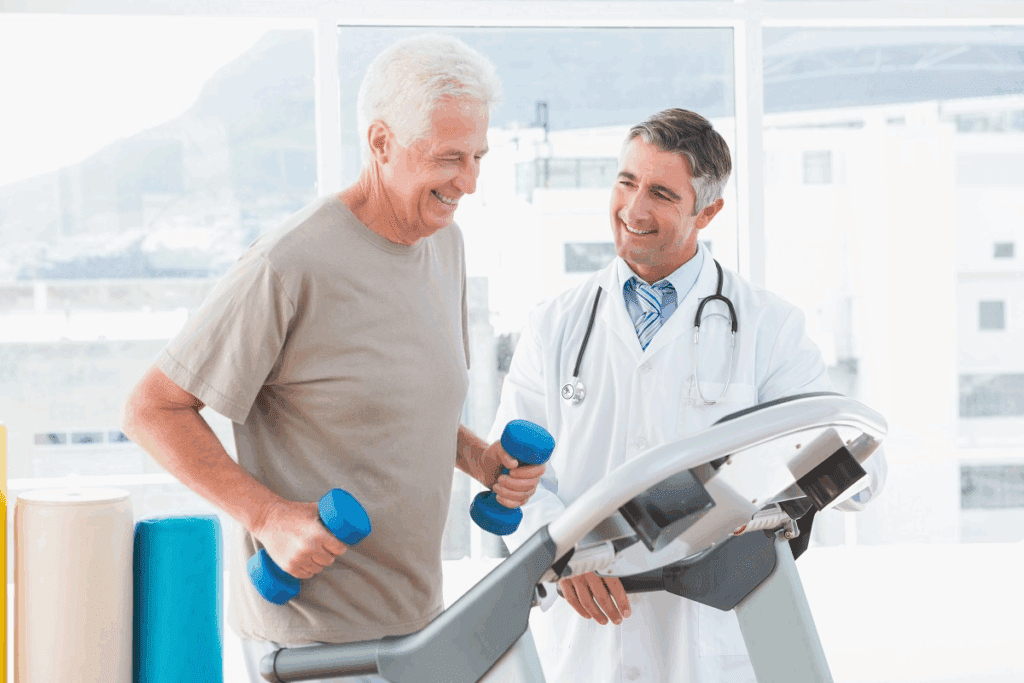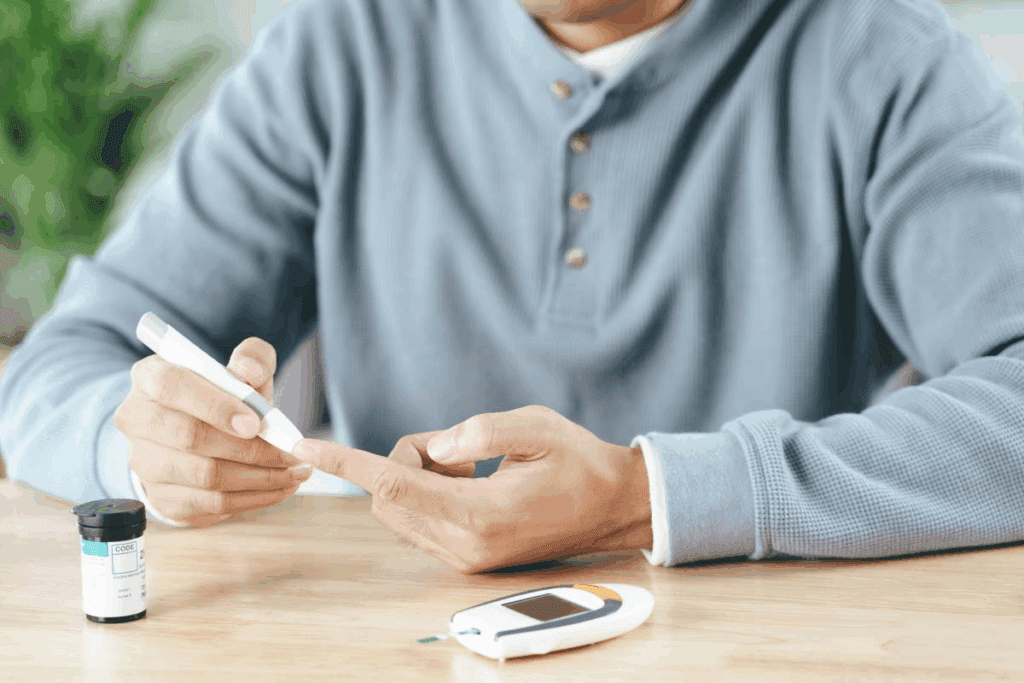Last Updated on November 25, 2025 by Ugurkan Demir

Starting a cardiac rehabilitation program is a big step after a heart event. We know it can feel overwhelming. But our guide is here to help. Cardiac rehab is a program that helps improve heart health, reduce symptoms, and boost overall well-being.
At Liv Hospital, our cardiac therapy programs are all about you. We use the latest research to help you recover and stay healthy. We mix exercise, education, and support to help you get stronger and more confident.

Learning about heart rehabilitation can greatly help those with heart issues. It’s a program to boost heart health for those with heart problems or who have had heart surgery. It’s all about getting better and feeling better.
Cardiac rehab is a program led by doctors. It includes exercise training, learning about heart-healthy living, and stress counseling. It’s made for each person’s needs to improve heart health and quality of life.
People who have had a heart attack, heart surgery, or heart failure should consider it. It’s also good for those who have had angioplasty or other heart issues. Our programs help them on their way to recovery.
Cardiac rehab offers many benefits. It improves physical function and reduces heart disease symptoms. It also boosts overall quality of life. Plus, it teaches how to manage risks to prevent future heart problems.
| Benefit | Description |
| Improved Physical Function | Enhanced ability to perform daily activities and exercise. |
| Reduced Symptoms | Decrease in symptoms such as chest pain and shortness of breath. |
| Enhanced Quality of Life | Improved overall well-being and mental health. |
| Risk Factor Management | Education and support to manage factors that contribute to heart disease. |
Understanding heart rehabilitation is key to a better recovery. Our programs offer full support, from exercise to nutrition and mental health help.

Before starting cardiac rehab, a detailed medical check is key. It helps figure out the best plan for you. This plan is tailored to meet your specific health needs.
A detailed medical check is needed to see what you can do physically and your health status. This check looks at your medical history, current health, and past heart issues. We also do tests to see how fit you are and if there are any risks.
The medical check may include:
A doctor usually refers you to cardiac rehab. This could be your family doctor, cardiologist, or another doctor. Talk to your doctor about wanting to join cardiac rehab. They will decide if it’s right for you.
| Referral Source | Description |
| Primary Care Physician | Your family doctor can send you to cardiac rehab based on your health and heart condition. |
| Cardiologist | A cardiologist can refer you based on your heart health and specific heart issues. |
At your first visit to cardiac rehab, you’ll get a full check to see your health and what you need. You’ll talk with doctors to make a plan just for you.
The first visit will include:
Knowing about the first steps in cardiac rehab helps you start your journey. We’re here to support you, giving you a caring and detailed approach to getting better.
Knowing the four phases of cardiac rehab is key for those starting this journey. These programs are all-inclusive. They make sure patients get the care and support they need at every step.
The first phase starts in the hospital. Inpatient rehabilitation focuses on getting patients moving and learning about their condition. It teaches them about lifestyle changes needed for recovery. Healthcare teams work with patients to lay the groundwork for their recovery.
After leaving the hospital, patients start early outpatient rehabilitation. This phase begins a few weeks later. It includes monitored exercise and more education on heart health. Patients are watched as they increase their activity, with programs tailored to their needs.
Intensive outpatient rehabilitation is the next step. Here, patients do more intense exercise and learn more about managing risks. The aim is to improve physical function and lower the risk of heart problems.
The last phase, maintenance and long-term recovery, helps keep up the progress made. It encourages a healthy lifestyle, including exercise and a balanced diet. This phase is vital for keeping heart health good over time.
By going through these four phases, patients can see big improvements in their heart health. Cardiac rehab is a journey that needs commitment and support. But with the right program, patients can look forward to a healthier future.
A good cardiac rehabilitation program is key for heart health and well-being. We think a complete approach helps patients get better and stay healthy after heart issues.
Such a program has important parts that help patients physically and emotionally. These parts meet the complex needs of heart patients. They make sure patients get the care and support they need to recover well.
Exercise training is a big part of cardiac rehab. It helps patients improve their heart health and get stronger. Exercise training programs are made just for each patient, based on their health and goals.
We use many types of exercises in our programs. This includes aerobic, strength, and flexibility exercises. This mix helps patients get better physically and lowers the chance of heart problems later.
Nutritional counseling is also key in cardiac rehab. Diet is very important for heart health. Our programs give patients advice on healthy eating.
We teach patients about eating well. This includes eating fruits, veggies, whole grains, and lean proteins. Making healthy lifestyle choices can greatly improve heart health and overall well-being.
Psychological support is very important in cardiac rehab. Heart disease can affect a person’s mind and emotions. Our programs offer counseling and support to help with stress, anxiety, and depression.
By focusing on the mind, we help patients find ways to deal with their feelings. This is important for recovery and a better quality of life.
Risk factor management is a big part of cardiac rehab. It’s about finding and managing factors that lead to heart disease. Our programs help patients understand and manage their risk factors.
We help patients deal with things like high blood pressure, high cholesterol, and smoking. This is done through lifestyle changes and sometimes medicine. Managing these risks can lower the chance of future heart problems.
Cardiac physical therapy is key in heart rehab programs. It offers exercises and techniques to boost heart health. We create these programs to fit the needs of heart patients, aiming to improve physical function and well-being.
Aerobic exercises are at the heart of cardiac physical therapy. They increase heart rate and blood flow, improving cardiovascular health. Examples include:
We adjust the intensity and length of aerobic exercises based on each patient’s fitness and health. Regular aerobic exercise can improve heart health, lessen symptoms, and boost physical function.
Strength training is also vital in cardiac physical therapy. It uses resistance to build muscle strength, aiding in daily activities and physical function. We often use:
Strength training can improve muscle mass, bone density, and metabolic health. It’s important to start with low-intensity exercises and gradually increase intensity based on patient tolerance and progress.
Flexibility and balance exercises are also key in cardiac physical therapy. They improve range of motion, reduce stiffness, and prevent falls. Examples include:
We add these exercises to enhance flexibility, balance, and physical function. They also help reduce injury risk and improve quality of life.
In conclusion, cardiac physical therapy includes various exercises and techniques for heart patients. By using aerobic conditioning, strength training, and flexibility and balance exercises, we help patients recover well and improve their heart health.
Choosing between facility-based and home-based heart rehabilitation depends on personal preference and medical needs. Cardiac rehabilitation programs are designed to be flexible, meeting different patient needs.
Traditional cardiac rehabilitation centers offer a structured and supervised environment. They have the latest equipment and staff who monitor and support patients.
Key benefits of facility-based rehab include:
Home-based cardiac rehabilitation programs offer flexibility and convenience. Patients can rehabilitate in their own homes. These programs use remote monitoring and guidance from healthcare professionals.
Advantages of home-based rehab include:
Hybrid approaches combine elements of both facility-based and home-based rehabilitation programs. This includes initial supervision at a center followed by home monitoring and support.
Hybrid models offer the best of both worlds. They provide the structured support of facility-based programs and the flexibility of home-based care.
| Rehabilitation Option | Key Features | Benefits |
| Facility-Based Rehab | Structured exercise programs, supervised by healthcare professionals | Access to medical team, social interaction |
| Home-Based Rehab | Flexible scheduling, remote monitoring | Convenience, personalized care |
| Hybrid Approach | Combination of facility-based and home-based care | Structured support and flexibility |
Cardiovascular therapy is key for patients with heart issues. It includes many treatments to help the heart and overall health. We focus on a full care plan, including special treatments, managing medicines, and advanced therapies for serious heart problems.
Our treatments are made just for each patient. They might include structured exercise programs, advice on nutrition, and ways to handle stress. We aim to care for the whole person, not just their physical health.
“Using different therapies together is key for the best results,” says a top expert in heart rehab. “By mixing physical training with education and behavior changes, we can greatly improve our patients’ lives.”
Managing medicines is a big part of heart care. During rehab, we watch patients closely and adjust their medicines as needed. We teach them how important it is to take their medicines as told and how each one helps their treatment.
For those with serious heart issues, new treatments offer hope. These might include cardiac resynchronization therapy (CRT) for heart failure, or other new treatments for specific heart problems. We keep up with the latest medical discoveries to give our patients the best care.
As we learn more about heart diseases, it’s clear that cardiovascular therapy is very important for long-term recovery. By using a variety of treatments, managing medicines well, and using advanced therapies when needed, we can really help patients with heart issues.
Cardiopulmonary rehab combines heart and lung therapy. It helps patients with both heart and lung problems. This program aims to boost health and well-being for those with heart and lung issues.
It’s great for those with heart failure and COPD. By treating both heart and lungs, we offer a full care approach.
It’s for people with heart and lung problems. This includes those who’ve had heart surgery or heart failure. It also helps those with lung diseases like COPD or pulmonary fibrosis.
We tailor our programs to each patient’s needs. This ensures they get the right care for their condition.
Patients with both heart and lung issues need special care. Our programs are designed to support their recovery. They help improve their quality of life.
By focusing on both heart and lungs, we aim for better health outcomes. We also lower the risk of complications.
Our programs use many treatment methods. These include exercise, nutrition advice, and mental support. This ensures patients get the care they need to manage their conditions.
With integrated treatment approaches, patients can improve their physical health. They can also reduce symptoms and feel better overall.
Cardiac rehabilitation is more than just treatment. It’s about watching how patients do and making sure they get better. We track many things to see if our programs are working well.
How well patients can move is a big sign of progress. We check this with several tests, like:
These physical performance metrics tell us a lot about how well patients are doing and if they’re ready for more challenges.
We also look at how well patients feel overall. This includes how well they can do everyday things, their mental health, and how happy they are. By using special tests, we see how our programs affect their lives.
Lowering risks for heart disease is a big part of our work. We help patients manage things like high blood pressure, bad cholesterol, and smoking. By watching these, we see if our programs are helping patients stay healthy longer.
Our cardiac rehab is all about helping patients get better. This includes physical therapy and cardiac rehab nursing to support their health. By focusing on these areas, we help our patients live better lives.
Finishing a cardiac rehab program is a big step towards better heart health. We’ve learned how it boosts physical function and overall well-being. It’s key to keep up the good work after leaving the program.
Living a healthy lifestyle is vital for lasting recovery. This means staying active, eating right, and managing stress. It’s also important to keep seeing healthcare pros at a heart rehab center for ongoing support.
By sticking to these habits, people can keep enjoying the benefits of cardiac rehab for many years. We’re here to help every step of the way. Our goal is to make sure you have a healthy and happy life after rehab.
Cardiac rehabilitation is a program that helps improve heart health. It includes exercise, education, and lifestyle changes.
It’s for people who have had heart issues or surgery. This includes heart attacks, surgery, or heart failure.
It improves physical function and reduces symptoms. It also boosts overall well-being and lowers future heart risks.
First, a medical check-up is done to see what you can do. Then, a plan is made just for you.
There are four phases. They are inpatient, early outpatient, intensive outpatient, and maintenance and long-term recovery.
It includes exercise, nutrition advice, mental support, and managing risks.
Exercises include aerobic, strength, and flexibility training. They help improve physical function and well-being.
Yes, home programs are available. They offer flexibility and can be customized to fit your needs.
It’s a program for heart and lung health. It’s for those with heart failure and lung diseases like COPD.
Progress is tracked through physical tests, quality of life checks, and managing risks. This helps tailor the program to you.
After finishing, you can keep up the good work. Stick to a healthy lifestyle and keep in touch with your doctor.
It’s specialized care for the heart. It includes treatments, medication, and advanced therapies for complex heart conditions.
Martinez-Lemus, L. A. (2012). The dynamic structure of arterioles. Basic & Clinical Pharmacology & Toxicology, 110(1), 5-11. https://pubmed.ncbi.nlm.nih.gov/21989114/
Subscribe to our e-newsletter to stay informed about the latest innovations in the world of health and exclusive offers!